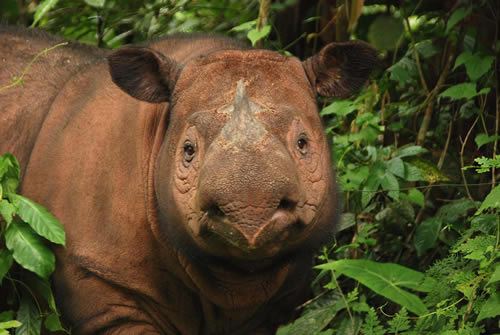
A report compiled by 8,000 scientists from the IUCN Species Survival Commission (IUCN SSC) has identified 100 of the world’s most threatened species.
The report, a comprehensive listing of endangered animals, plants, and fungi from 48 countries titled Priceless of Worthless? was presented at the IUCN World Conservation Congress held from September 6th — 15th, 2012, in Jeju, South Korea.
“If we ignore the question, and fail to take action, we shall be inadvertently accepting the ethical position that human-caused mass extinction is acceptable,” says Dr. Simon Stuart, Chair of the IUCN Species Survival Commission.
Recent extinctions
In June 2012, Lonesome George passed away. He was the world’s last Pinta Island tortoise — the subspecies was literally eaten to death — and with his passing, the Chelonoidis nigra abingdoni is extinct.
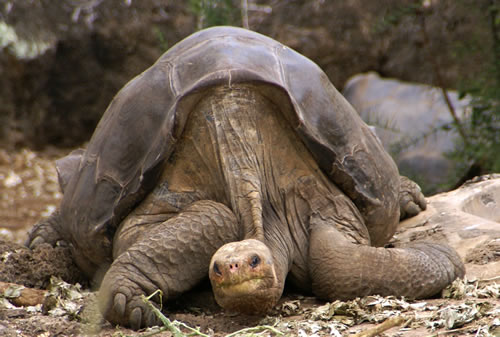
More bad news followed in August. The Japan Times reported that the Japanese river otter, Lutra lutra whiteleyi, was extinct. There had been no sightings since 1979.
The extinction of the Vietnamese Javan rhino, Rhinoceros sondaicus annamiticus was confirmed in October 2011, along with another rhino subspecies, the Western black rhino, Diceros bicornis longipes.
Lonesome George, the last Japanese river otter, Vietnamese Javan rhino, Western black rhino, and sadly so many others we have lost, have a common story: The demise of these species was entirely man-made — and thus preventable.
We can take action in time to prevent the extinction of the 100 species on this list — but will we?
The entire list
- Ploughshare tortoise, Angonoka, Astrochelys yniphora
Population: 440 — 770 individuals
Range: 25 — 60km2 in Baly Bay region, northwestern Madagascar
Threats: Illegal collection for international pet trade - Rio Pescado stubfoot toad, Atelopus balios
Population: Unknown
Range: Azuay, Cañar and Guyas provinces, south-western Ecuador
Threats:
Chytridiomycosis and habitat destruction due to logging and agricultural expansion - Northern Muriqui, Wooly Spider Monkey, Brachyteles hypoxanthus.
Population size: < 1,000 individuals
Range: Atlantic forest, south-eastern Brazil.
Threats: Habitat loss and fragmentation due to large-scale deforestation and selective logging - Pygmy three-toed sloth, Bradypus pygmaeus
Population: < 500 individuals
Range: Approximately 1.3km2 — 1.5km2 on Isla Escudo de Veraguas, Panama
Threats: Habitat loss due to illegal logging of mangrove forests for firewood and construction and hunting of the sloths - Tarzan’s chameleon, Calumma tarzan
Population: Unknown
Range: < 10km2 in Anosibe An’Ala region, eastern Madagascar
Threats: Habitat destruction for agriculture - Seychelles sheath-tailed bat, Coleura seychellensis
Population: < 100 mature individuals
Range: Two small caves on Silhouette and Mahé, Seychelles
Threats: Habitat degradation and predation by invasive species - Jamaican iguana, Jamaican rock iguana, Cyclura collei
Population: Unknown
Range: < 10km2 core area in Hellshire Hills, Jamaica
Threats: Predation by introduced species and habitat destruction - Cayman Islands ghost orchid, Dendrophylax fawcettii
Population: Unknown
Range: 6 acres in Ironwood Forest, George Town, Grand Cayman
Threats: Habitat destruction due to infrastructure development - Wild yam, Dioscorea strydomiana
Population: 200 individuals
Range: Oshoek area, Mpumalanga, South Africa
Threats: Collection for medicinal use - Spoon-billed sandpiper, Eurynorhyncus pygmeus
Population: < 100 breeding pairs
Breeds in Russia, migrates along the East Asian-Australasian Flyway to wintering grounds in Bangladesh and Myanmar.
Threats: Trapping on wintering grounds and land reclamation. - Liben lark, Heteromirafa sidamoensis
Population: 90 — 256 individuals
< 36km2 in the Liben Plains, southern Ethiopia
Threats: Habitat loss and degradation due to agricultural expansion, overgrazing and fire suppression - Singapore freshwater crab, Johora singaporensis
Population: Unknown
Range: Bukit Timah Nature Reserve and streamlet near Bukit Batok, Singapore
Threats: Habitat degradation – reduction in water quality and quantity - Edwards’s pheasant, Lophura edwardsi
Population: Unknown
Range: Quang Binh, Quang Tri and Thua Thien-Hue, Viet Nam
Threats: Hunting and habitat loss - Attenborough’s pitcher plant, Nepenthes attenboroughii
Population:Unknown
Range: < 1km2 on either side of the summit of Mount Victoria, Palawan, Philippines
Threats: Poaching - Luristan newt, Neurergus kaiseri
Population: < 1,000 mature individuals
Range: < 10km2 area of occupancy in Zagros Mountains, Lorestan, Iran
Threats: Illegal collection for pet trade - Vaquita, Phocoena sinus
Population: < 200 individuals and declining
core area of approximately 2,500km2 in Northern Gulf of California, Mexico
Threats: Incidental capture in gillnets - Greater bamboo lemur, Prolemur simus
Population: 100 — 160 individuals
Range: Southeastern and southcentral rainforests of Madagascar
Threats: Habitat destruction due to slash-and-burn agriculture, mining and illegal logging - Saola, Pseudoryx nghetinhensis
Population: Unknown
Range: Annamite mountains, on the Viet Nam — PDR Laos border
Threats: Hunting and habitat destruction - Red River giant softshell turtle, Rafetus swinhoei
Population: 4 individuals
Range: Hoan Kiem Lake and Dong Mo Lake, Viet Nam, and Suzhou Zoo, China
Threats: Hunting for consumption and habitat destruction and degradation as a result of wetland destruction and pollution - Javan rhino, Rhinoceros sondaicus
Population: < 50 individuals
Range: Ujung Kulon National Park, Java, Indonesia
Threats: Hunting for traditional medicine and small population size - Cebu frill-wing, Risiocnemis seidenschwarzi
Population: Unknown
Range: < 1km2 in a rivulet beside the Kawasan River, Cebu, Philippines
Threats: Habitat degradation and destruction - Red-finned Blue-eye, Scaturiginichthys vermeilipinnis
Population: 2,000 — 4,000 individuals
Range: Edgbaston Station, central western Queensland, Australia
Threats: Predation by introduced species - Estuarine pipefish, Sygnathus watermeyeri
Population: Unknown
Range: Kariega Estuary to East Kleinemonde Estuary, Eastern Cape Province, South Africa
Threats: Construction of dams altering river flows and flood events into estuaries - Suicide Palm, Dimaka, Tahina spectabilis
Population: 90 individuals
Range: Analalava district, north-western Madagascar
Threats: Habitat loss due to fires, logging and agricultural developments - Bullock’s false toad, Telmatobufo bullocki
Population: Unknown
Range: < 500km2, Nahuelbuta, Arauco Province, Chile
Threats: Habitat destruction as a result of construction of a hydro-electricity scheme - Baishan fir, Abies beshanzuensis
Population: 5 mature individuals
Range: Baishanzu Mountain, Zhejiang, China
Threats: Agricultural expansion and fire - Actinote zikani
Population: Unknown
Range: Near Sao Paulo, Atlantic forest, Brazil
Threats: Habitat degradation due to pressure from human populations - Leaf scaled sea-snake, Aipysurus foliosquama
Population: Unknown
Range: Ashmore Reef and Hibernia Reef, Timor Sea
Threats: Unknown – likely degradation of coral reef habitat - Amani flatwing, Amanipodagrion gilliesi
Population: < 500 individuals
Range: < 10km2 area of occupancy, Amani-Sigi Forest, Usamabara Mountains, Tanzania
Threats: Habitat degradation due to increasing population pressure and water pollution - Araripe manakin, Antilophia bokermanni
Population: 779 individuals
Range: 28km2 distribution, Chapado do Araripe, South Ceará, Brazil
Threats: Habitat destruction due to expansion of agriculture and recreational facilities and water diversion - Antisolabis seychellensis
Population: Unknown
Range: 5km2 area of occupancy, Morne Blanc, Mahé island, Seychelles
Threats: Invasive species and climate change - Aci Göl toothcarp, Aphanius transgrediens
Population: few hundred pairs
Range: small springs, south-eastern shore of former Lake Aci, Turkey
Threats: Competition and predation by Gambusia and road construction - Bulmer’s fruit bat, Aproteles bulmerae
Population: approximately 150 individuals
Range: < 10km2 area of occupancy, Luplupwintern Cave, Western Province, Papua New Guinea
Threats: Hunting and cave disturbance - White bellied heron, Ardea insignis
Population: 70 — 400 individuals
Range: 56,300km2 in Bhutan, North East India and Myanmar
Threats: Habitat destruction and degradation due to hydropower development - Great Indian bustard, Ardeotis nigriceps
Population: 50 — 249 mature individuals
Range: 570,000km2 in Rajasthan, Gujarat, Maharashta, Andhra Pradesh, Karnataka and Madhya, India
Threats: Habitat loss and modification due to agricultural development - Madagascar pochard, Aythya innotata
Population: approx 20 mature individuals
Range: 1km2 volcanic lakes north of Bealanana, Madagascar
Threats: Habitat degradation due to slash-and-burn agriculture, hunting,
and fishing/introduced fish - Galapagos damsel fish, Azurina eupalma
Population: Unknown
Range: Unknown
Threats: Climate Change – oceanographic changes associated with the 1982 / 1983 El Nino are presumed to be responsible for the apparent disappearance of this species from the Galapagos - Giant yellow croaker, Bahaba taipingensisPopulation: Unknown
Range: Chinese coast from Yangtze River, China to Hong Kong
Threats: Over-fishing, primarily due to value of swim-bladder for traditional medicine - Common batagur, Four-toed terrapin, Batagur baska
Population: Unknown
Range: Bangladesh, Cambodia, India, Indonesia and Malaysia
Threats: Illegal export and trade from Indonesia to China - Bazzania bhutanicaPopulation: Unknown
Range: < 10km2 area of occupancy in Budini and Lafeti Khola, Bhutan
Threats: Habitat degradation and destruction due to forest clearance, overgrazing and development - Hirola, Beatragus hunteri
Population: < 1,000 individuals
Range: South-east Kenya and possibly south-west Somalia
Threats: Habitat loss and degradation, competition with livestock, poaching - Franklin’s bumblebee, Bombus franklini
Population: Unknown
Range: Oregon and California, United States of America
Threats: Disease from commercially bred bumblebees and habitat destruction and degradation - Callitriche pulchra
Population: Unknown
Range: 2m x 1m pool on Gavdos, Greece
Threats: Exploitation of the species’ habitat by stock, and modification of the pool by local people - Santa Catarina’s guinea pig, Cavia intermedia
Population: 40 — 60 individuals
Range: 4ha on Moleques do Sul Island, Santa Catarina, Brazil
Primary threats: Habitat disturbance and possible hunting; small population effects - Roloway guenon, Cercopithecus roloway
Population: Unknown
Range: Cote d’Ivoire
Threats: Hunting for consumption as bushmeat and habitat loss - Willow blister, Cryptomyces maximus
Population: Unknown
Range: Pembrokeshire, United Kingdom
Threats: Limited availability of habitat - Nelson’s small-eared shrew, Cryptotis nelsoni
Population: Unknown
Range: < 100km2 extent of occurance, Volcán San Martín Tuxtla, Veracruz, Mexico
Threats: Habitat loss due to logging, cattle grazing, fire and agriculture - Sumatran rhino, Dicerorhinus sumatrensis
Population: < 200 individuals
Range: Sabah, Sarawak and Peninsular Malaysia, Kalimantan and Sumatra, Indonesia
Threats: Hunting for traditional medicine - Amsterdam albatross, Diomedea amsterdamensis
Population: 100 mature individuals
Range: Breeds on Plateuau des Tourbières, Amsterdam Island, Indian Ocean.
Threats: Disease and incidental by-catch in long-line fishing operations - Diospyros katendei
Population: 20 individuals, one population
Range: Kasyoha-Kitomi Forest Reserve, Uganda
Threats: High pressure from
communities for agricultural activity, illegal tree felling, habitat degradation due to alluvial gold digging and small population - Dipterocarpus lamellatus
Population: 12 individuals
Range: Siangau Forest Reserve, Sabah, Malaysia
Threats: Habitat loss and degradation due to logging of lowland forest and creation of industrial plantations - Hula painted frog, Discoglossus nigriventer
Population: Unknown
< 2km2 in Hula Valley, Israel
Threats: Predation by birds and range restriction due to habitat destruction - Dombeya mauritania
Population: Unknown
Range: Mauritius
Threats: Habitat degradation and destruction due to encroachment by alien invasive plant species and cannabis cultivation - Elaeocarpus bojeri
Population: < 10 individuals
Range: Grand Bassin, Mauritius
Threats: Habitat degradation - La Hotte glanded frog, Eleutherodactylus glandulifer
Population: Unknown
Range: Massif de la Hotte, Haiti
Threats: Habitat destruction
due to charcoal production and slash-and-burn agriculture - Macaya breast-spot frog, Eleutherodactylus thorcetes
Population: Unknown
Range: Formon and Macaya peaks,Masif de la Hotte, Haiti
Threats: Habitat destruction due to charcoal production and slash-and-burn agriculture - Chilenito, Eriosyce chilensis
Population: < 500 individuals
Range: Pta Molles and Pichidungui, Chile
Threats: Collection of flowering individuals - Coral tree, Erythrina schliebenii
Population: < 50 individuals
Namatimbili-Ngarama Forest, Tanzania
Threats: Limited habitat and small population size increasing vulnerability to stochastic events - Euphorbia tanaensis
Population: 4 mature individuals
Range: Witu Forest Reserve, Kenya
Threats:Illegal logging and habitat
degradation due to agricultural expansion and infrastructure development - Ficus katendei
Population: < 50 mature individuals
Range: Kasyoha-Kitomi Forest Reserve, Ishasha River, Uganda
Primary threats: Agricultural activity, illegal tree felling and habitat degradation due to alluvial gold digging - Northern bald ibis, Geronticus eremita
Population size: 200 — 249 mature individuals
Range: Breeds in Morocco, Turkey and Syria. Syrian population winters in central Ethiopia
Threats: Habitat degradation and destruction, and hunting - Gigasiphon macrosiphon
Population: 33 mature individuals
Range: Kaya Muhaka, Gongoni and Mrima Forest Reserves, Kenya, Amani Nature Reserve, West Kilombero Scarp Forest Reserve, and Kihansi Gorge, Tanzania
Threats: Timber extraction and habitat degradation due to agricultural encroachment and development, seed predation by wild pigs - Gocea ohridana
Population: Unknown
Range: < 10km2 area of occupancy, Lake Ohrid, Macedonia
Threats: Habitat degradation due
to increasing pollution levels, off-take of water and sedimentation events - Table mountain ghost frog, Heleophryne rosei
Population: Unknown
Range: 9km2, Table Mountain, Western Cape Province, South Africa
Threats: Habitat degradation due to invasive plants and water abstraction - Hemicycla paeteliana
Population: Unknown
Range: 8km2 area of occupancy, Jandia peninsula, Fuerteventura, Canary Islands
Threats: Habitat destruction due to overgrazing and trampling by goats and tourists - Hibiscadelphus woodii
Population: Unknown
Range: Kalalau Valley, Hawaii
Threats: Habitat degradation due to feral ungulates and invasive introduced plant species - Sakhalin taimen, Hucho perryi
Population: Unknown
Range: 233,498km2 area of occupancy,Russian far east and northern Japan
Primary threats: Overfishing (sport fishing and commercial bycatch) and habitat loss from damming, agriculture and other land use practices - Belin vetchling, Lathyrus belinensis
Population: < 1,000
Range: < 2km2, outskirts of Belin village, Antalya, Turkey
Threats: Habitat destruction due to urbanisation, over-grazing, conifer planting and road widening - Archey’s frog, Leiopelma archeyi
Population size: Unknown
Range: Coromandel peninsula and Whareorino Forest, New Zealand
Threats: Chytridiomycosis and predation by invasive species - Dusky gopher frog, Lithobates sevosus
Population: 60 — 100 individuals
Range: < 10km2 area of occupancy in Harrison County, Mississippi, USA
Primary threats: Fungal disease and habitat limitation due to climate change and land-use changes - Magnolia wolfii
Population: < 5 individuals
Range: Risaralda, Columbia
Primary threats: Isolation of species and low regeneration rates - Margaritifera marocana
Population: < 250 individuals
Range: Oued Denna, Oued Abid and Oued Beth, Morocco
Threats: Habitat degradation and disturbance due to pollution and development - Moominia willii
Population: <500 individuals
Range: 0.02km2 area of occupancy on Silhouette Island, Seychelles
Threats: Invasive species and climate change - Cuban greater funnel eared bat, Natalus primus
Population: < 100 individuals
Range: Cueva La Barca, Isle of Pines, Cuba
Threats: Habitat loss and human disturbance - Hainan gibbon, Nomascus hainanus
Population: < 20 individuals
Range: 10km2 area of occupancy on Hainan Island, China
Threats: Hunting - Mulanje red damsel, Oreocnemis phoenix
Population size: Unknown
Range: < 10km2 area of occupancy, Mulanje Plateau, Malawi
Threats: Habitat destruction and degradation due to drainage, agricultural expansion and exploitation of forest - Pangasid catfish, Pangasius sanitwongsei
Population: Unknown
Range: Chao Phraya and Mekong basins in Cambodia, China, Lao PDR, Thailand
and Viet Nam
Threats: Overfishing and collection for aquarium trade - Parides burchellanus
Population: < 100 individuals
Range: Cerrado, Brazil
Threats: Habitat degradation due to pressure from human populations and range restriction - Picea neoveitchii
Population: Unknown
Range: Qinling Range, China
Threats: Forest destruction - Qiaojia pine, Pinus squamata
Population: < 25 mature individuals
Range: Qiaojia, Yunnan, China
Threats: Limited distribution and small population size - Gooty tarantula, metallic tarantula, peacock parachute spider, peacock tarantula, Salepurgu, Poecilotheria metallica
Population: Unknown
Range: Nandyal and Giddalur, Andhra Pradesh, India
Threats: Habitat loss and degradation as a result of deforestation, firewood collection and civil unrest - Fatuhiva monarch, Pomarea whitneyi
Population: 50 individuals
Range: Fatu Hiva, Marquesas Islands, French Polynesia
Threats: Predation by introduced species – Rattus rattus and feral cats - Common sawfish, Pristis pristis
Population: Unknown
Range: Coastal tropical and subtropical waters of Indo-Pacific and Atlantic Oceans. Currently largely restricted to northern Australia
Threats: Exploitation has removed the species from 95 per cent of its historical range - Silky sifaka, Propithecus candidus
Population: 100 — 1,000 individuals
Range: Maroantsetra to Andapa basin, and Marojeju Massif, Madagascar
Threats: Hunting and habitat disturbance - Geometric tortoise, Psammobates geometricus
Population: Unknown
Range: Western Cape Province, South Africa
Primary threats: Habitat destruction and degradation, and predation - Psiadia cataractae
Population: Unknown
Range: Mauritius
Threats: Habitat degradation and destruction due to development project and alien invasive plant species - Beydaglari bush-cricket, Psorodonotus ebneri
Population: Unknown
Range: Beydaglari range, Antalaya, Turkey
Threats: Climate change and habitat loss - Tonkin snub-nosed monkey, Rhinopithecus avunculus
Population: < 200 individuals
Range: Northeastern Viet Nam
Threats: Habitat loss and hunting - West Australian underground orchid, Rhizanthella gardneri
Population: < 100 individuals
Range: Western Australia, Australia
Threats: Land clearance for agriculture (96 per cent habitat cleared to date), climate change and salinisation - Boni giant sengi, Rhynchocyon sp.
Population: Unknown
Range: Boni-Dodori Forest, Lamu area, Kenya
Threats: Habitat destruction due to development - Rosa arabica
Population size: unknown, 10 subpopulations
Range: 14.6km2, St Katherine Mountains, Egypt
Threats: Domestic animals grazing, climate change and drought, medicinal plant collection and restricted range - Durrell’s vontsira, Salanoia durrelli
Population: Unknown
Range: estimated to be 200km2 in marshes of Lake Alaotra, Madagascar
Primary threats: Habitat loss - Red crested tree rat, Santamartamys rufodorsalis
Population: Unknown
Range: Sierra Nevada de Santa Marta, Colombia
Threats: Habitat loss through urban development and coffee cultivation - Angel shark, Squatina squatina
Population size: Unknown
Range: Formerly coastal waters of NE Atlantic as far north as Norway and into the Mediterranean Sea. Now restricted to Canary Islands only
Primary threats: Benthic trawling - Chinese crested tern, Sterna bernsteini
Population: < 50 mature individuals
Range: Breeding in Zhejiang and Fujian, China, and outside breeding season in Indonesia,Malaysia, Philippines, Taiwan, Thailand
Threats: Egg collection and habitat destruction - Okinawa spiny rat, Tokudaia muenninki
Population: Unknown
Range: 3km2 on Okinawa Island, Japan
Threats: Habitat loss and predation by feral cats - Somphongs’s rasbora, Trigonostigma somphongsi
Population size: Unknown
Range: Mae Khlong basin, Thailand
Threats: Habitat loss and degradation from farmland conversion and urbanization - Valencia letourneuxi
Population: Unknown
Range: Southern Albania and Western Greece
Threats: Habitat destruction, water abstraction and aggressive interaction with Gambusia - Forest coconut, Voanioala gerardii
Population: < 10 individuals
Range: Masoala peninsula, Madagascar
Threats: Harvesting for consumption of palm heart and deforestation

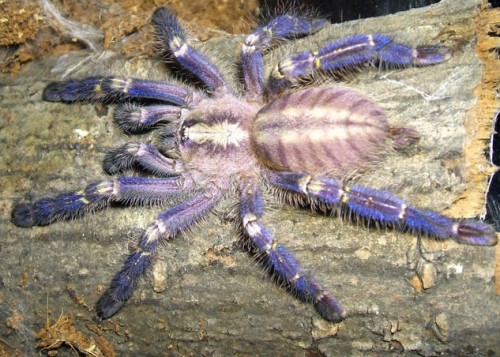
And number 100 is Attenborough’s echidna, Zaglossus attenboroughi. Population size: Unknown. Range: Cyclops Mountains, Papua Province, Indonesia. Threats: Habitat modification and degradation due to logging, agricultural encroachment shifting cultivation and hunting by local people.
‘Priceless or worthless?’
“We need to decide where we stand on this moral and ethical issue and implement and enforce national and international laws accordingly,” says Professor Jonathan Baillie, Director of Conservation Programmes, Zoological Society of London. “So it is up to us. The future of these species depends on our values; are they priceless or worthless?”
100 species: Priceless or worthless? I say priceless.
But are humans up to the task, or will we yet again fail our fellow species, just as we failed Lonesome George and Rhinoceros sondaicus annamiticus?
Source: IUCN
Photos: Dicerorhinus sumatrensis © Bill Konstant/International Rhino Foundation; Eurynorhyncus pygmeus by JJ Harrison via Wikimedia Commons; Poecilotheria metallica by Morkelsker via Wikimedia Commons

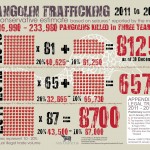

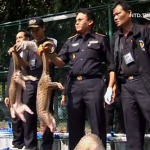

I had no idea there were so many endangered species!
I know there are a lot of great organisations out there who do a tremendous amount of work to save species from extinction, but I just think the Governments could do much more. It’s a bit too late when they’ve gone!